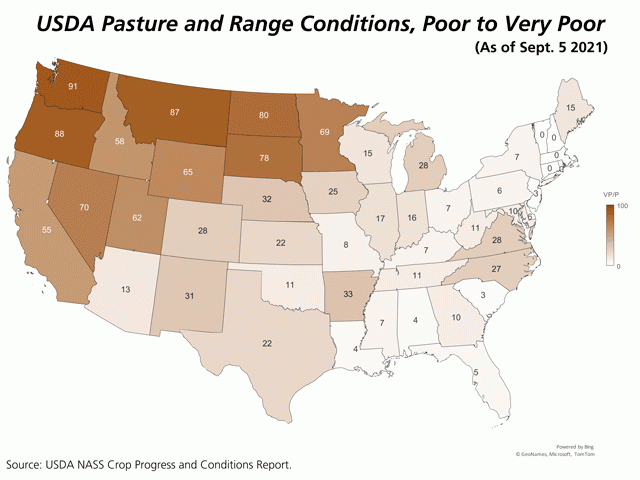USDA Offers Aid for Feed Trucking Costs
Ranchers in Drought Can Get Some Relief for High Feed Transportation Costs
OMAHA (DTN) -- Ranchers who have been hauling hay or feed for livestock that typically graze will be eligible to receive aid funds from USDA to offset some of those transportation costs.
The program could provide some relief for ranchers in the western half of the country who have been facing extreme to exceptional drought conditions throughout much of 2021. The move by USDA also may help those producers make decisions on their herd for the fall and winter months, Agriculture Secretary Tom Vilsack said in the news release.
"USDA is currently determining how our disaster assistance programs can best help alleviate the significant economic, physical and emotional strain agriculture producers are experiencing due to drought conditions," Vilsack said. "The duration and intensity of current drought conditions are merciless, and the impacts of this summer's drought will be felt by producers for months to come. Today's announcement is to provide relief as ranchers make fall and winter herd management decisions."
USDA announced Wednesday it is updating the Emergency Assistance for Livestock, Honey Bees and Farm-raised Fish Program, known as ELAP, with a permanent change to cover feed transportation costs for farmers in drought-affected areas. Producers will be able to apply at their local USDA Service Center for that aid starting later this month.
ELAP had already been adjusted to cover the costs of hauling water during a drought. For transportation costs, eligible ranchers will be reimbursed 60% of the feed transportation costs "above what would have been incurred in a normal year." Farmers considered as socially disadvantaged, of limited resources, beginning or a military veteran could be eligible for reimbursement of 90% of those feed transportation costs.
P[L1] D[0x0] M[300x250] OOP[F] ADUNIT[] T[]
Under a national formula, USDA will offset feed transportation costs after the first 25 miles up to 1,000 miles. The calculation will then exclude the normal costs to transport hay or feed if the producer normally buys feed. USDA will use a cost of $6.60 per mile before the 60% to 90% calculation is applied. The mileage also may be adjusted on a state or regional basis.
For example, a producer who paid to have bales of hay hauled 175 miles would be paid on 150 miles. That 150 miles would be multiplied by $6.60 to get $990. The $990 is multiplied by 0.60 to arrive at $594 eligible payment.
Transportation costs for feed will be covered in the following conditions:
-- The area where haying and grazing resources are depleted has been in a D2 "severe" drought for eight consecutive weeks as indicated by the U.S. Drought Monitor. https://droughtmonitor.unl.edu/…
-- The area has been under a drought of D3 "extreme" drought or greater.
-- USDA has determined a shortage of local or regional feed availability.
USDA will accept feed transportation costs that were incurred on Jan. 1, 2021, or after. Producers will self-certify their costs to their local FSA office, but producers also are encouraged to keep records and receipts in case documentation is requested. The deadline to file for this payment for 2021 is Jan. 31, 2022.
ELAP also will offer cost-share assistance for the costs of treating hay or feed to prevent the spread of invasive pests such as fire ants, USDA stated.
Sen. John Hoeven, R-N.D., noted in a news release he had been working with USDA to help boost drought aid for producers, including aid that would help offset the costs of trucking feed to livestock that normally graze.
Chris Clayton can be reached at Chris.Clayton@dtn.com
Follow him on Twitter @ChrisClaytonDTN
(c) Copyright 2021 DTN, LLC. All rights reserved.






